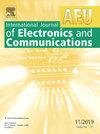Cavity-stacked filter in CLAF-SIW technology for millimeter waves
IF 3
3区 计算机科学
Q2 ENGINEERING, ELECTRICAL & ELECTRONIC
Aeu-International Journal of Electronics and Communications
Pub Date : 2025-03-01
DOI:10.1016/j.aeue.2025.155725
引用次数: 0
Abstract
This work presents the design of a cavity-stacked bandpass filter (BPF) using contactless air-filled substrate integrated waveguide (CLAF-SIW) technology for millimeter-wave frequencies. This technology is a variant of air-filled SIW technology, incorporating contactless techniques. It enables the reduction of dielectric losses in SIW filters while supporting multilayer structures with robust assembly. The cavity-stacked filter topology allows for very good frequency responses with a reduced footprint and no transitions needed. As an example, a 4th-order Chebyshev bandpass filter composed of four stacked cavities, coupled through irises, is shown. The iris layers are fabricated by metallizing the slot edges of a PCB, while the cavity layers are implemented using CLAF-SIW. The filter has been designed and manufactured to provide a passband response from 36 GHz to 37.5 GHz. A good agreement between measurement and simulation has been achieved. The losses in the proposed CLAF-SIW filter are primarily due to the metal roughness of the low-cost commercial laminates used.
毫米波CLAF-SIW技术中的空腔堆叠滤波器
这项工作提出了一种使用非接触式充气衬底集成波导(CLAF-SIW)技术的毫米波频率的空腔堆叠带通滤波器(BPF)的设计。该技术是充气SIW技术的一种变体,结合了非接触式技术。它可以减少SIW滤波器中的介电损耗,同时支持具有坚固组件的多层结构。空腔堆叠滤波器拓扑结构允许非常好的频率响应,减少占用空间,不需要转换。作为一个例子,显示了一个由四个堆叠腔组成的四阶切比雪夫带通滤波器,通过虹膜耦合。虹膜层是通过金属化PCB的槽边来制造的,而腔层是使用CLAF-SIW实现的。该滤波器的设计和制造可提供36 GHz至37.5 GHz的通带响应。实验结果与仿真结果吻合较好。所提出的CLAF-SIW滤波器的损耗主要是由于所使用的低成本商用层压板的金属粗糙度。
本文章由计算机程序翻译,如有差异,请以英文原文为准。
求助全文
约1分钟内获得全文
求助全文
来源期刊
CiteScore
6.90
自引率
18.80%
发文量
292
审稿时长
4.9 months
期刊介绍:
AEÜ is an international scientific journal which publishes both original works and invited tutorials. The journal''s scope covers all aspects of theory and design of circuits, systems and devices for electronics, signal processing, and communication, including:
signal and system theory, digital signal processing
network theory and circuit design
information theory, communication theory and techniques, modulation, source and channel coding
switching theory and techniques, communication protocols
optical communications
microwave theory and techniques, radar, sonar
antennas, wave propagation
AEÜ publishes full papers and letters with very short turn around time but a high standard review process. Review cycles are typically finished within twelve weeks by application of modern electronic communication facilities.

 求助内容:
求助内容: 应助结果提醒方式:
应助结果提醒方式:


